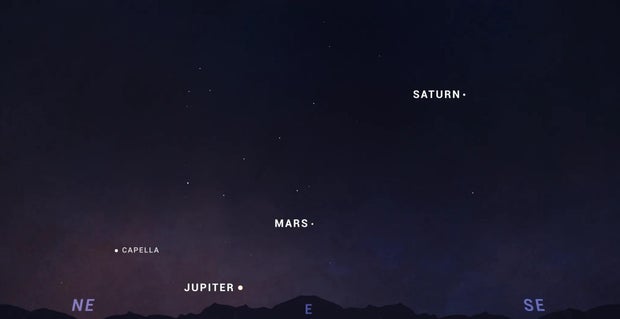You may have heard about a “parade of planets” that was set to grace the early morning skies on Monday morning with a rare celestial event. But if you missed it, don’t worry – experts say you were misled, and there will be another time soon to better see a planetary lineup.
Talk of the June 3 “parade of planets” seemed to stem from a social media post from the space news site “Latest in Space.” In a May 21 post, Latest in Space said that “in a rare event, six planets will align in a straight line on Monday (June 3) just before sunrise in the northern hemisphere,” claiming that Mercury, Jupiter, Uranus, Mars, Neptune and Saturn “will all be visible.”
Many quickly took it to mean that all of the planets would be visible to the naked eye. But according to the experts, no such “spectacular celestial event” was set to appear this morning.
According to space news site Space.com, planets simply cannot be seen as disks to the naked eye – even the brightest ones will twinkle as stars. The set positioning of the planets this morning also proved problematic to the event, as Mercury and Jupiter “will be very close to the position of the sun in the sky and thus likely will be masked by the brilliant glow of morning twilight,” the website said. The two planets could be visible with binoculars, but one would need a flat horizon and no obstructions to see them, the site said.
Uranus is visible to the naked eye, but only in dark and non-polluted skies, but because it was only set to rise about an hour before sunrise this morning, the sky was already too bright to really see it.
“If you step outside at around 3:30 or 4 a.m. on Monday morning, don’t expect to be awed by the sight of a planet parade,” Space.com said. “What you will likely see is a crescent moon and a bright orange ‘star’ shining to its right (Mars) and farther off to the right will be another relatively bright ‘star’ glowing with a yellowish-white hue (Saturn).”
The website also noted that while seeing such a parade would be rare, planets aligning isn’t a rare event as they are all on an orbital plane.
NASA has also confirmed that Monday morning’s alignment wasn’t all that it was cracked up to be.
“In reality, only two of the six planets supposedly on display (Saturn and Mars) will actually be visible,” NASA said. “In early June, Jupiter and Mercury will be at or below the horizon in morning twilight and not visible; Uranus and Neptune are far too faint to see without a telescope, especially as the morning sky brightens.”
The closest thing to a “parade of planets” will happen on June 29, NASA said, when Saturn, the moon, Mars, and Jupiter will line up in the morning.
NASA/JPL-Caltech
Space.com also noted another planetary lineup that’s set for next winter. According to the site, the moon, Saturn, Venus and Jupiter will be aglow in the early evening sky on Jan. 31, 2025, and/or Feb. 1. Mars will also be visible and “more than six times brighter than it appears to us now.”
“Compared to all that, the ballyhooed “Parade of Planets” on June 3 can best be described with a single word: underwhelming,” the site said.


